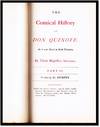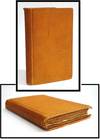1889 · London
by D'Urfey, Thomas
London: Printed for J. Darby, 1889. Limited Edition Copy 29 of 100. Very Good/No Dust Jacket.
Peach colored cloth with blind-stamped borders; 8vo; 7.75 inches tall; iv, 305 pages; printed on watermarked laid-paper. The bindings are tight and square. Text is clean; light, even age-toning. Moderate shelf handling wear with tiny corner rubs. Cloth is hand-soiled.. Thomas D'Urfey's The Comical History of Don Quixote is a satirical adaptation of Cervantes' famous novel, written as a three-part play and performed at the Queen's Theatre in Dorset Garden during the late 17th century. The parts were first published between 1694 and 1696. D'Urfey's (truncated)
Peach colored cloth with blind-stamped borders; 8vo; 7.75 inches tall; iv, 305 pages; printed on watermarked laid-paper. The bindings are tight and square. Text is clean; light, even age-toning. Moderate shelf handling wear with tiny corner rubs. Cloth is hand-soiled.. Thomas D'Urfey's The Comical History of Don Quixote is a satirical adaptation of Cervantes' famous novel, written as a three-part play and performed at the Queen's Theatre in Dorset Garden during the late 17th century. The parts were first published between 1694 and 1696. D'Urfey's (truncated)







